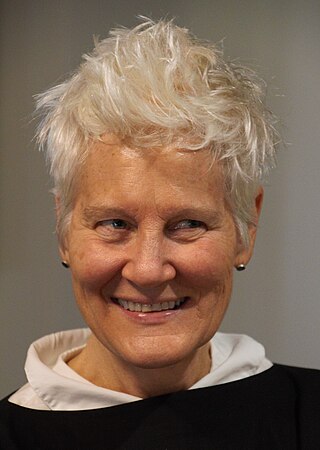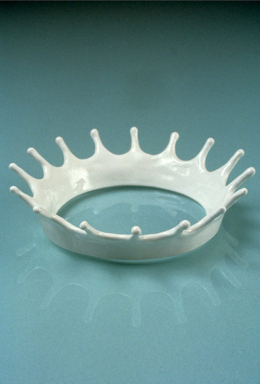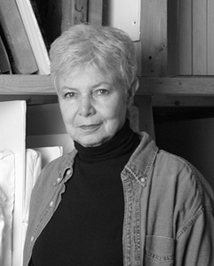
Yayoi Kusama is a Japanese contemporary artist who works primarily in sculpture and installation, and is also active in painting, performance, video art, fashion, poetry, fiction, and other arts. Her work is based in conceptual art and shows some attributes of feminism, minimalism, surrealism, Art Brut, pop art, and abstract expressionism, and is infused with autobiographical, psychological, and sexual content. She has been acknowledged as one of the most important living artists to come out of Japan, the world's top-selling female artist, and the world's most successful living artist. Her work influenced that of her contemporaries, including Andy Warhol and Claes Oldenburg.
Martha Rosler is an American artist. She is a conceptual artist who works in photography and photo text, video, installation, sculpture, and performance, as well as writing about art and culture. Rosler's work is centered on everyday life and the public sphere, often with an eye to women's experience. Recurrent concerns are the media and war, as well as architecture and the built environment, from housing and homelessness to places of passage and systems of transport.

Carol Bove is an American artist based in New York City. She lives and works in Brooklyn.

Ann Hamilton is an American visual artist who emerged in the early 1980s known for her large-scale multimedia installations. After receiving her BFA in textile design from the University of Kansas in 1979, she lived in Banff, Alberta, and Montreal, Quebec, Canada before deciding to pursue an MFA in sculpture at Yale in 1983. From 1985 to 1991, she taught on the faculty of the University of California at Santa Barbara. Since 2001, Hamilton has served on the faculty of the Department of Art at the Ohio State University. She was appointed a Distinguished University Professor in 2011.

Jessica Stockholder is a Canadian-American artist known for site-specific installation works and sculptures that are often described as "paintings in space." She came to prominence in the early 1990s with monumental works that challenged boundaries between artwork and display environment as well as between pictorial and physical experience. Her art often presents a "barrage" of bold colors, textures and everyday objects, incorporating floors, walls and ceilings and sometimes spilling out of exhibition sites. Critics suggest that her work is informed by diverse artistic traditions, including abstract expressionism, color field painting, minimalism and Pop art. Since her early career, they have noted in her work an openness to spontaneity, accident and marginality and a rejection of permanency, monetization and disciplinary conventions that Stephen Westfall characterized as an "almost shocking sense of freedom."

Alyson Shotz is an American sculptor based in Brooklyn, New York. She is known for experiential, large-scale abstract sculptures and installations inspired by nature and scientific concepts, which manipulate light, shadow, space and gravity in order to investigate and complicate perception. Writers suggest her work challenges tenets of monumental, minimalist sculpture—traditionally welded, solid, heavy and static—through its accumulation of common materials in constructions that are often flexible, translucent, reflective, seemingly weightless, and responsive to changing conditions and basic forces. Sculpture critic Lilly Wei wrote, "In Shotz’s realizations, the definition of sculpture becomes increasingly expansive—each project, often in series, testing another proposition, another possibility, another permutation, while ignoring conventional boundaries."

Ranjani Shettar is a visual artist from Bangalore, India known for her large-scale sculptural installations. Her work has been displayed at The Metropolitan Museum of Art, the Museum of Modern Art (MoMA), the San Francisco Museum of Modern Art (SFMoMA), among others.

Michelle Lopez is an American sculptor and installation artist, whose work incorporates divergent industrial materials to critique present day cultural phenomena. She lives and works in Brooklyn, New York.

Ellen Harvey is an American-British conceptual artist known for her painting-based practice and site-specific works in installation, video, engraved mirrors, mosaic and glass. She frequently pairs traditional representational vocabularies and genres with seemingly antithetical postmodern strategies, such as institutional critique, appropriation, mapping and pastiche. Her work examines such themes as art as a mirror, interactions between built environment and landscape, ruins and the Picturesque aesthetic, and cultural and economic relationships between museums, artists and publics. Curator Henriette Huldisch writes of her work, "haunted as it is by the notion of art's ultimate futility, her paradoxical stake is in persistently testing art's possibility to do something in the world after all."

Bonnie Collura is an American artist known for figurative multi-media sculptures, textiles and installations created by processes of compositing and sampling. Her art oscillates between abstraction and figuration, mixing aesthetics from baroque sculpture, contemporary animation and quilting with iconic fragments from pop culture, art history and myth. She has embraced theatricality and excess, intertextuality and digital-age influences in her work, often exploring hybridized, disjointed bodies, surrogate characters and reconfigured literary tropes. Sculpture critic Ann Landi has written, "Collura incorporates wildly diverse materials and processes while also drawing on a wide array of references—everything from cartoons and movies like Star Wars to highbrow texts such as The Prince and Frankenstein … Diffuse and open-ended, appealing to storytelling and world-making, her work continues to evolve, carrying on a feminist tradition in its materials and mythologies."
Cynthia Carlson is an American visual artist, living and working in New York.

Xaviera Simmons is an American contemporary artist. She works in photography, performance, painting, video, sound art, sculpture, and installation. Between 2019 and 2020, Simmons was a visiting professor and lecturer at Harvard University. Simmons was a Harvard University Solomon Fellow from 2019-2020. Simmons has stated in her lectures and writings that she is a descendant of Black American enslaved persons, European colonizers and Indigenous persons through the institution of chattel slavery on both sides of her family's lineage.

Polly E. Apfelbaum is an American contemporary visual artist, who is primarily known for her colorful drawings, sculptures, and fabric floor pieces, which she refers to as "fallen paintings". She currently lives and works in New York City, New York.

Jennifer Bolande is an American postconceptual artist. Her art explores affinities and shifts of meaning among sets of objects and images across different contexts and media including sculpture, photography, film and installation. She emerged in the early 1980s with work that expanded on ideas and strategies rooted in conceptualism, Pop, Arte Povera and the so-called Pictures Generation. Her work focuses on thresholds, liminal and peripheral spaces, and transitional moments—states she enacts by the repetition, accumulation and recontextualization of found materials. She frequently selects cultural artifacts on the verge of obsolescence or in flux—and thus acquiring new meanings—and archives, studies and reframes them. Artforum critic Paula Marincola wrote, "Bolande's highly individualized amalgam of sculpture and photography proceeds obliquely but precisely toward an accumulation of possible meanings. She is a connoisseur of unlikely but evocative details, of subliminally perceived, fragmentary images and events."

Kimsooja was born in Daegu, South Korea. Kimsooja is a multi-disciplinary conceptual artist who travels between her three homes and places of work in New York City, Paris, and Seoul. In 1980 Kim graduated with a B.F.A in Painting from Hong-Ik University, Seoul and continued to pursue her M.F.A there, obtaining the degree in 1984 at the age of 27. Her origin as a painter was a crucial starting point for the development of her art. That same year, she received a scholarship to study art at Ecole Nationale Supérieure des Beaux-Arts in Paris, France, where she studied Printmaking. Her first solo exhibition was held in 1988 at Gallery Hyundai, Seoul. Currently, her work is featured in countless international museums and galleries as well as public art fairs and other spaces. Her practice combines performance, film, photo, and site-specific installation using textile, light, and sound. Kimsooja's work investigates questions concerning the conditions of humanity, while engaging issues of aesthetics, culture, politics, and the environment. Her principle of ‘non-doing’ and ‘non-making,’ which follows a conceptual and structural investigation of performance through modes of mobility and immobility, inverts the notion of the artist as the predominant actor.
Samara Golden is an American artist based in Los Angeles.

Merle Temkin is a New York City-based painter, sculptor and installation artist, known for vibrant, abstracted paintings based on her own enlarged fingerprint, and earlier site-specific, mirrored installations of the 1980s. Her work has often involved knitting-like processes of assemblage and re-assemblage, visual fragmentation and dislocation, and explorations of identity, the hand and body, and gender. In addition, critics have remarked on the play in her work between systematic experimentation and intuitive exploration. Her painted and sewn "Fingerprints" body of work has been noted for its "handmade" quality and "sheer formal beauty" in the Chicago Sun-Times and described elsewhere as an "intensely focused," obsessive joining of thread and paint with "the directness and desperation of marks on cave walls." Critic Dominique Nahas wrote "Temkin's labor-intensive cartography sutures the map of autobiography onto that of the universal in sharply revelatory ways." Her public sculptures have been recognized for their unexpected perceptual effects and encouragement of viewer participation. Temkin's work has been featured in publications including the New York Times, Artforum, ARTnews, New York Magazine, and the Washington Post. Her work belongs to the permanent collections of the Racine Art Museum, Museum of Arts and Design in New York, and Israel Museum, among others.

Karyn Olivier is a Philadelphia-based artist who creates public art, sculptures, installations and photography. Olivier alters familiar objects, spaces, and locations, often reinterpreting the role of monuments. Her work intersects histories and memories with present-day narratives.

Jane Benson is a British multidisciplinary artist. She is known for her immersive geopolitical and research based practice that spans across sculpture, installation, sound, video, institutional critique and collaborations with musicians.

Dawn DeDeaux is an American visual artist based in New Orleans, Louisiana whose practice has included installation art, sculpture, photography, technology and multimedia works. Since the 1970s, her work has examined social, political and environmental issues encountered at both the global and local level of her native Louisiana. In 2014, American Theatre wrote that she created "immersive, future-tense" work at the intersection of visual arts, electronically driven theatre and site-specific installation, with sculpture, drawings and digital technology "inspired by ancient myths, mathematical forecasts, symbols, visions of apocalyptic landscapes and utopian longings."



















